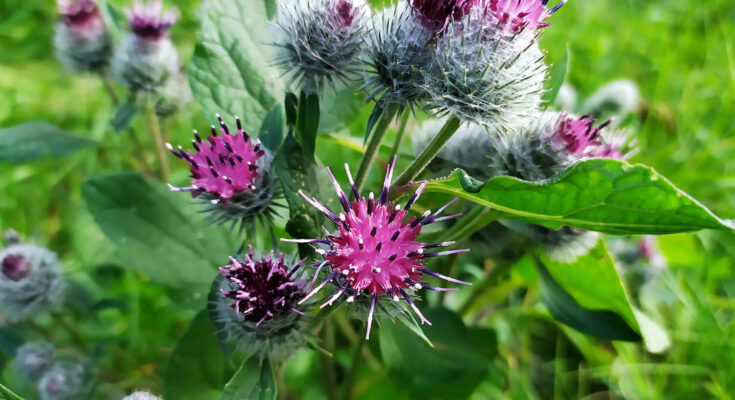Burdock (Arctium lappa) is a versatile plant, known not only for its prickly appearance but also for its impressive medicinal and nutritional benefits. Commonly found in temperate regions, particularly in Europe, Asia, and North America, burdock has been used for centuries in traditional medicine and cuisine. Every part of this plant — from its roots to its leaves and stalks — offers unique health benefits. In this article, we will explore how each part of burdock can contribute to well-being.
1. The Roots: A Powerhouse of Nutrients
The root of the burdock plant is perhaps the most well-known and widely used part. It is rich in fiber, antioxidants, and essential nutrients, which make it a cornerstone of traditional herbal medicine. Burdock root has been used in Asian, European, and Native American cultures for its purported detoxifying, anti-inflammatory, and digestive properties.
Key Benefits of Burdock Root:
- Detoxification and Cleansing: Burdock root is often considered a powerful blood purifier. It helps the body eliminate toxins by stimulating the liver and kidneys, which are key organs in detoxification. Its high fiber content also supports regular bowel movements, assisting the body in expelling waste.
- Anti-Inflammatory Effects: Burdock root contains compounds like arctiin and arctigenin, which have anti-inflammatory properties. It can be particularly beneficial for conditions like arthritis, where inflammation plays a central role in pain and discomfort.
- Skin Health: Burdock root has been used in topical applications to treat skin issues such as eczema, acne, and psoriasis. Its antibacterial and anti-inflammatory qualities help reduce skin irritation and promote healing.
- Rich in Antioxidants: The root is packed with antioxidants such as quercetin, luteolin, and phenolic acids, which protect the body from oxidative stress and free radical damage. These antioxidants also support overall immune health and can help slow the aging process.
How to Use Burdock Root: Burdock root can be consumed fresh, dried, or in powdered form. It is commonly found in teas, tinctures, capsules, and herbal extracts. It can also be boiled, steamed, or stir-fried for culinary uses, particularly in Asian cuisine, where it is a popular ingredient in soups and stews.
2. The Leaves: A Natural Remedy for Inflammation and Infection
While the root of burdock is the most famous, the leaves also offer significant health benefits. Large, heart-shaped, and full of vital nutrients, burdock leaves have been traditionally used for their medicinal properties, especially in the treatment of skin conditions and infections.
Key Benefits of Burdock Leaves:
- Anti-inflammatory Properties: Like the root, burdock leaves contain compounds that can help reduce inflammation. A poultice made from the leaves has been used in folk medicine to soothe irritated skin, relieve muscle soreness, and reduce swelling in joints.
- Antimicrobial Effects: The leaves of burdock have demonstrated antimicrobial properties, making them useful for preventing infections and promoting healing. When applied topically, the leaves can help fight off bacteria and fungi, particularly in wounds or minor skin infections.
- Diuretic and Detoxifying: Burdock leaves are also known for their diuretic properties, which support the elimination of excess fluids and toxins through the urine. This can help reduce bloating and promote kidney health.
How to Use Burdock Leaves: Burdock leaves can be used topically as a poultice or in herbal baths to soothe the skin. For internal use, the leaves can be made into a tea or included in tinctures to take advantage of their detoxifying and anti-inflammatory benefits.
3. The Stalks: A Nutritional Addition to Your Diet
While the stalks of burdock are often overlooked, they are actually edible and offer their own nutritional benefits. These fibrous stems can be consumed both raw and cooked, providing a mild, slightly sweet flavor and a crunchy texture.
Key Benefits of Burdock Stalks:
- Rich in Fiber: Like the root, the stalks are high in dietary fiber, which aids digestion and promotes gut health. Fiber helps regulate blood sugar levels, supports healthy cholesterol levels, and keeps you feeling fuller longer.
- Minerals and Vitamins: Burdock stalks contain important minerals such as potassium, calcium, and magnesium, which support heart health, bone health, and muscle function. They are also a source of vitamins like vitamin C and several B vitamins, which contribute to energy metabolism and immune system function.
- Antioxidants: While the stalks do not contain as many antioxidants as the root, they still provide some protection against free radicals and oxidative stress.
How to Use Burdock Stalks: Burdock stalks can be eaten raw, especially when young and tender, or cooked in a variety of ways. They can be boiled, stir-fried, or pickled, and are often included in Japanese and Korean dishes such as “gobo” (Japanese burdock root) and “kimchi.”
4. The Stems: Harnessing the Benefits of Burdock’s Structural Elements
While not commonly consumed, burdock stems (the main trunks of the plant) have their own medicinal uses. These stems, though harder and more fibrous than the rest of the plant, still offer some interesting applications in herbal medicine.
Key Benefits of Burdock Stems:
- Anti-inflammatory: Like the other parts of the plant, the stems contain compounds that help reduce inflammation. When boiled or used in tea form, the stems can help alleviate joint pain and muscle stiffness.
- Mild Digestive Aid: The stems contain some mild laxative properties and can aid in digestion. They can help relieve constipation and promote regularity.
- Skin Healing: Though less commonly used than the leaves and roots, the stems of burdock can be used in topical applications to treat skin conditions such as rashes, irritation, and small cuts.
How to Use Burdock Stems: Burdock stems are less commonly used than other parts of the plant, but they can be boiled or steeped in tea to extract their medicinal benefits. In some cases, they may also be incorporated into topical ointments or poultices.
A Treasure Trove of Benefits
Burdock is a truly remarkable plant, offering a wealth of health benefits from its roots, leaves, stalks, and stems. Whether used for detoxification, inflammation reduction, skin care, or nutritional purposes, every part of this plant has something valuable to offer. Incorporating burdock into your wellness routine can be as simple as enjoying a cup of burdock root tea or adding fresh stalks to a stir-fry.
As always, when using burdock for medicinal purposes, it’s advisable to consult with a healthcare provider, especially if you are pregnant, nursing, or taking medications. Nonetheless, this humble plant provides a wide range of potential benefits that are well worth exploring for those interested in natural remedies and holistic health.



